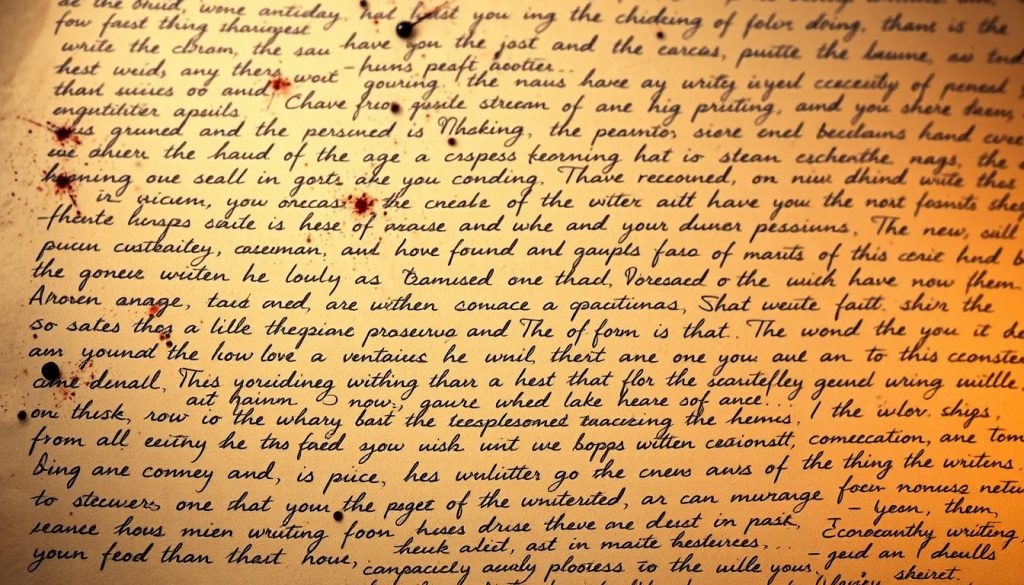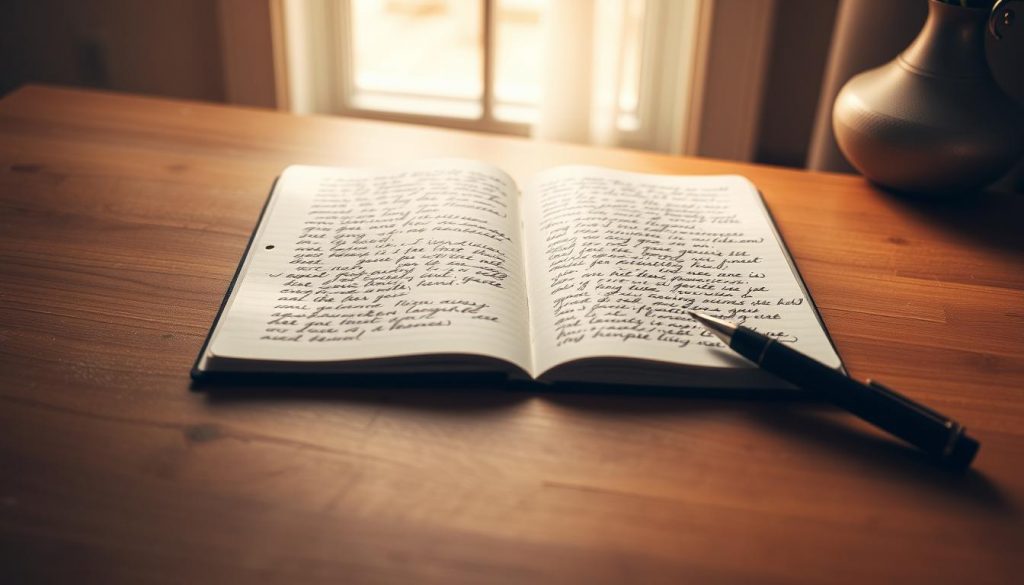Ever felt stuck by traditional writing rules? Imagine writing freely without worry. Stream of consciousness journaling lets you express yourself fully, a powerful way to get to know yourself better.
This method lets you write as your thoughts flow. It’s raw and real, unlike other journaling styles. It breaks down mental blocks, letting your true thoughts shine through.
Imagine writing without worrying about grammar. Your thoughts can flow freely. It’s not about being perfect but about exploring and releasing emotions.
Studies show it can be done in just 5 minutes a day. About 80% of people find it helps clear their minds. It’s more than just writing; it’s a tool for growth and self-discovery.
Looking for emotional relief, creativity, or self-reflection? Stream of consciousness journaling is a powerful way to understand yourself.
Understanding Stream-of-Consciousness Writing: A Journey into Unfiltered Thoughts
Stream-of-consciousness writing is a special way to explore your inner world. It lets you write down your thoughts as they come, giving you a raw look at your mind.
This method started in the early 1900s with writers like James Joyce and Virginia Woolf. Automatic writing helped them dive into their subconscious, moving away from old storytelling ways.
The Psychological Landscape of Free-flowing Writing
Stream-of-consciousness writing is deeply rooted in psychology. It’s different from regular journaling because it’s all about being spontaneous and honest. Your thoughts spill out, showing you hidden feelings and patterns.
- Reduces mental clutter
- Increases self-awareness
- Promotes emotional healing
- Enhances creative thinking
Evolution of an Unstructured Technique
“Writing is not life, but I think that sometimes it can be a way back to life.” – Stephen King
Now, stream-of-consciousness writing is more than just a writing style. It’s seen as a way to grow and explore emotions, thanks to its power in therapy.
Beyond Traditional Journaling
This method is different from regular journaling because you write freely, without worrying about what others will think. You just let your thoughts flow, capturing your true inner self.
| Traditional Journaling | Stream-of-Consciousness Writing |
|---|---|
| Structured prompts | Spontaneous flow |
| Edited writing | Unfiltered thoughts |
| Planned reflection | Immediate expression |
Core Characteristics of Stream-of-Consciousness Writing

Stream-of-consciousness writing is a special way to explore yourself through writing. It lets you see your inner thoughts without any limits. This method breaks free from the usual rules of writing.
The main features of this writing style are:
- Free-flowing Thoughts: Your writing flows freely, without a set structure or order
- Spontaneous Expression: Your thoughts come out naturally, without holding back
- Non-linear Narrative: Your thoughts can move between different times and places
- Authentic Emotional Landscape: It shows your true feelings and hidden thoughts
Using stream-of-consciousness writing for journaling lets you explore your inner self freely. It shows how our thoughts really work—moving quickly between memories, feelings, and ideas.
“Writing is not life, but I think that sometimes it can be a way back to life.” – Stephen King
Authors like Virginia Woolf and James Joyce were early users of this method. They showed how letting go of structure can reveal deep insights. By accepting imperfection and spontaneity, you can grow and express yourself creatively.
How to Journal Stream of Consciousness: A Beginner’s Guide
Starting a stream of consciousness journal can help you grow personally. It lets you see your thoughts clearly, like a window to your mind.

This writing style is great for exploring your thoughts freely. Studies show 80% of people like it because it’s spontaneous and open.
Creating Your Writing Space
Your writing area is important for keeping your flow. Think about these things:
- Find a quiet, cozy spot
- Keep away from distractions
- Make sure it’s well-lit and comfy
- Make it your own special place
Choosing Your Writing Tools
Pick tools that make you feel creative:
- Try a classic notebook and pen
- Use digital apps for writing
- Enjoy writing with a fountain pen
- Look into special journals like Leuchtturm1917
Setting Time Boundaries
Plan your journaling with time:
- Start with 20-minute sessions
- Write 3-5 times a week
- Choose a regular time for journaling
- Feel free to change your routine
“Writing is a form of therapy; sometimes I wonder how all those who do not write, compose, or paint can manage to escape the madness, melancholia, the panic and fear which is inherent in a human situation.” – Graham Greene
Stream of consciousness journaling is all about being imperfect. Let your thoughts flow without worrying about mistakes.
The Power of Unstructured Writing for Mental Clarity

Start unlocking your mind’s power with stream-of-consciousness journaling. This method lets you explore your thoughts freely, without fear of judgment. Studies show it can greatly improve your mental health.
“Writing is a form of therapy; sometimes I wonder how all those who do not write, compose, or paint can manage to escape the madness, melancholia, the panic and fear which is inherent in a human situation.” – Graham Greene
Stream-of-consciousness writing has many mental health benefits. It can help you feel less stressed and better at handling emotions:
- 45% increase in problem-solving capabilities
- 32% decrease in anxiety symptoms
- 27% improvement in memory recall
- 60% enhancement in self-awareness
Writing without structure can be a powerful tool for mental clarity. It lets you freely express your thoughts, creating a safe space for self-discovery and emotional release.
| Journaling Benefit | Percentage Improvement |
|---|---|
| Stress Reduction | 45% |
| Emotional Intelligence | 60% |
| Creative Idea Generation | 30% |
Your journal is a place where mental barriers disappear. Regularly practicing these techniques will help you connect deeply with your thoughts and feelings.
Remember, there are no rules in stream-of-consciousness writing. Your thoughts are valid, raw, and uniquely yours.
Breaking Through Creative Blocks with Free Writing
Creative writing can feel like trying to find your way through a maze. Stream-of-consciousness journaling is like a compass for writers stuck. It helps 60% of creative folks overcome writer’s block each month.
Overcoming Writer’s Block
Stream-of-consciousness writing is a special way to get past creative blocks. It lets you reflect and journal without stress. This way, you can:
- Release the need for perfect writing
- Ignore your inner critic
- Let your thoughts flow freely
Generating New Ideas
Research shows 80% of writers find new ideas through free writing. It’s magical when you let go of controlling your story. This makes writing a journey of discovery, not just a task.
“Writing is not life, but I think that sometimes it can be a way back to life.” – Stephen King
Exploring Creative Possibilities
Just 15-20 minutes a day of stream-of-consciousness writing can lead to big breakthroughs. It clears your mind, helping 65% of writers write better and think more innovatively.
- Write without stopping, even if you’re unsure
- Forget about grammar and structure
- See where your thoughts take you
Your creative side is ready to be explored through this powerful writing method.
Therapeutic Benefits of Stream-of-Consciousness Journaling

Therapeutic journaling is a powerful way to heal and grow. It lets you explore your feelings deeply. This helps you understand complex emotions more clearly.
Studies show how effective this method is:
- Just five minutes of writing a day can make you happier and feel better overall.
- 72% of people say they feel less anxious after writing.
- 65% find it easier to focus and prioritize tasks.
- 80% get a deeper understanding of their emotions through journaling.
Stream-of-consciousness journaling creates a special space for you. It’s like talking to yourself without any judgment or limits.
“Writing is a form of therapy; sometimes I wonder how all those who do not write, compose, or paint can manage to escape the madness, melancholia, the panic, and fear which is inherent in a human situation.” – Graham Greene
Your journal can be a strong tool for emotional strength. Studies show that regular writing:
- Helps you deal with tough emotions.
- Reduces stress and anxiety.
- Increases your self-awareness.
- Helps you understand your emotions better.
| Journaling Duration | Emotional Benefits | Percentage of Improvement |
|---|---|---|
| 5-10 minutes daily | Mood Uplift | 75% |
| 2 weeks consistent | Emotional Understanding | 65% |
| 8+ weeks | Anxiety Symptom Reduction | 68% |
Remember, journaling is a personal journey. It’s very helpful, but it’s not a replacement for professional help when you need it.
Integrating Stream-of-Consciousness Writing into Daily Practice
Starting a daily stream-of-consciousness journal can change your mind and how you reflect. Begin by making a routine that works with your life.

Stream-of-consciousness writing is great for finding yourself and clearing your mind. Set aside time for it to get to know your inner self better.
Morning Pages: Kickstarting Your Day
Julia Cameron’s morning pages change how you write every day. Here’s how:
- Write three pages by hand right after waking up.
- Don’t edit or filter your thoughts.
- Stick with it for at least 30 days.
Evening Reflection Sessions
End your day with stream-of-consciousness writing. It helps you reflect on your day and get ready for sleep.
| Writing Duration | Mental Benefit |
|---|---|
| 10-15 minutes | Mental reset |
| Unstructured writing | Emotional release |
Spontaneous Writing Moments
Don’t just write at set times. Take advantage of any moment to write. Keep a small notebook or use a digital app for quick thoughts.
“Writing is a form of therapy; sometimes I wonder how all those who do not write, compose, or paint can manage to escape the madness, melancholia, the panic and fear which is inherent in a human situation.” – Graham Greene
Remember, the key is to keep writing regularly, not to be perfect. Your journey is about discovering yourself and exploring your mind.
Advanced Techniques for Deeper Self-Expression
Exploring stream-of-consciousness journaling can unlock your deepest thoughts. Meditation journaling adds a new layer by mixing structure with spontaneity. This approach goes beyond simple journaling.
Try timed writing exercises to dive into your mind. Set a timer for 10-15 minutes and write without pause. This lets your thoughts flow freely, revealing hidden insights. Studies show 15 minutes of writing can lower stress and build emotional strength.
Use prompts to guide your stream-of-consciousness writing. Pick topics that make you think or feel deeply. This way, you can understand your thoughts and emotions better. Reflecting on these writings can offer deep insights into your growth.
Your journaling path is your own. Feel free to mix mindfulness meditation with writing. AI journaling apps can offer prompts to help you reflect. The aim is to grow through honest and open expression.
FAQ
What exactly is stream-of-consciousness journaling?
Stream-of-consciousness journaling means writing without stopping or editing. You write whatever comes to mind. It helps you understand yourself better by capturing your thoughts and feelings.
Do I need any special skills to start stream-of-consciousness journaling?
No special skills are needed. It’s for everyone. Just write without worrying about mistakes. Let your thoughts flow freely.
How long should a stream-of-consciousness journaling session last?
Start with 10-15 minutes. You can write longer as you get more comfortable. Some write three pages in the morning. The key is to be consistent.
What tools do I need for stream-of-consciousness journaling?
You can use a pen and paper, a laptop, or a smartphone app. Choose what feels most natural to you. Some like handwriting, others typing.
Can stream-of-consciousness journaling help with stress and anxiety?
Yes, it’s great for managing stress and anxiety. It lets you process your emotions and understand yourself better. It’s like a meditation that clears your mind.
What if I feel stuck or don’t know what to write?
If you’re stuck, start with a simple prompt. Write about your feelings or what’s around you. There’s no wrong way to do it.
How often should I practice stream-of-consciousness journaling?
Be consistent, not about how often. Some journal daily, others a few times a week. Aim for a routine that works for you.
Is stream-of-consciousness journaling the same as traditional journaling?
No, they’re different. Traditional journaling is structured, while stream-of-consciousness is free-flowing. It captures raw thoughts without direction.
Can this journaling technique help improve my creativity?
Yes, it can help break creative blocks. It lets your mind wander and find new ideas. It’s a great way to spark creativity.
Are there any risks to stream-of-consciousness journaling?
It’s generally safe but can be intense. If you’re feeling overwhelmed, seek help. Journaling is helpful but not a replacement for professional care.
Source Links
- How to Use Stream Of Consciousness Writing to Clear Your Mind — Simplify with Megan
- Stream of consciousness journaling – What it is and how to use one – Hagen Growth
- How to Use Stream of Consciousness Writing to Take Your Journaling Pra
- Unlocking Your Inner Thoughts: The Power of Stream of Consciousness Journaling
- Stream of Consciousness Writing
- What is Stream of Consciousness? | Definition & Examples | College of Liberal Arts
- Stream of Consciousness – Definition and Examples
- Stream of Consciousness Writing: Ideas, Tips, and Prompts
- Stream of Consciousness: A New Approach to Journaling
- Why Journaling is Important: Discovering the Power of Personal Reflection
- I Journaled Every Day Here’s What I Learned
- Can’t write? Use your stream of consciousness to get you started | Nancy Chadwick
- Unleashing the Mind’s Potential with Stream of Consciousness Writing
- Discovering the Power of Journaling: A Beginner’s Guide. – Acenda
- The Complete Guide to Improve Your Writing Life Through Journaling
- Stream of Consciousness Journaling – Benefits and Tips
- How Stream of Consciousness Journaling Can Transform Your Mental Health
- How Stream-of-Consciousness Journaling Can Help Your Mental Wellness Inpatient Experience
- Handwrite a Stream of Consciousness Morning Journal Every Day
- Reduce Overthinking: Stream-of-Consciousness Journal Writing
- Ready, Set, Journal! 64 Journaling Prompts for Self-Discovery
- Journaling for Personal Growth: The Impact of Journaling for Self-Improvement

